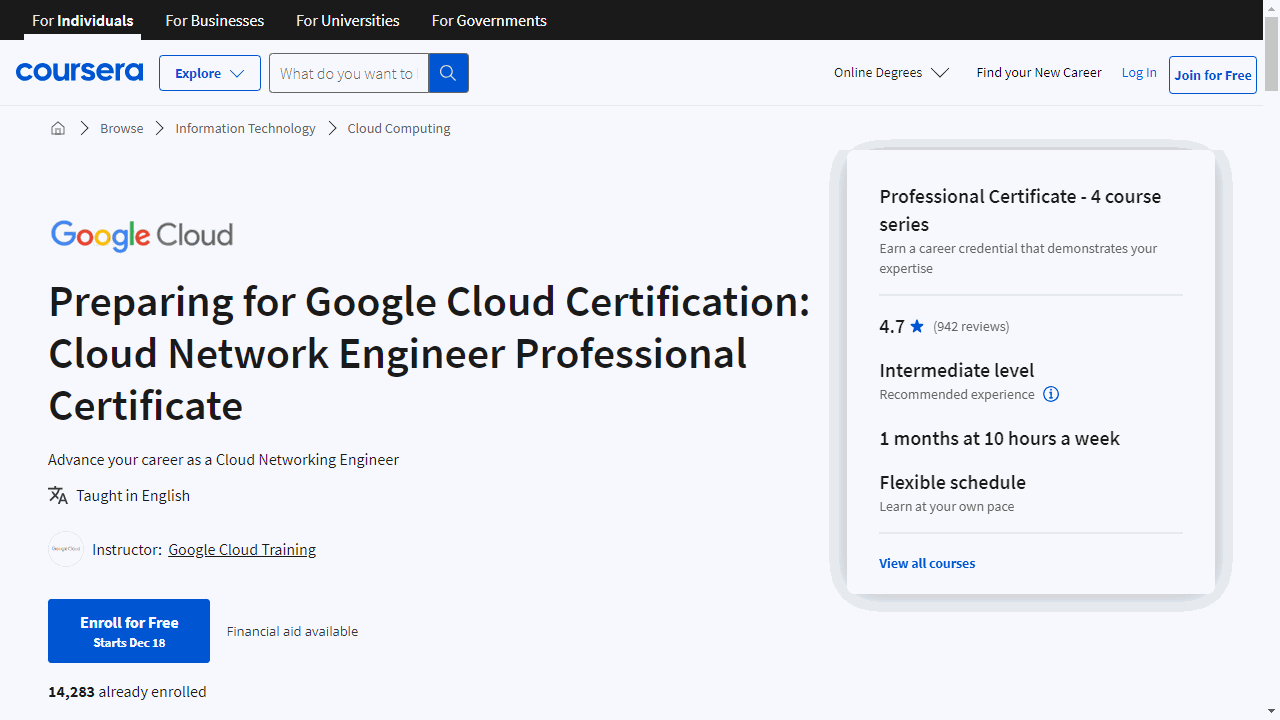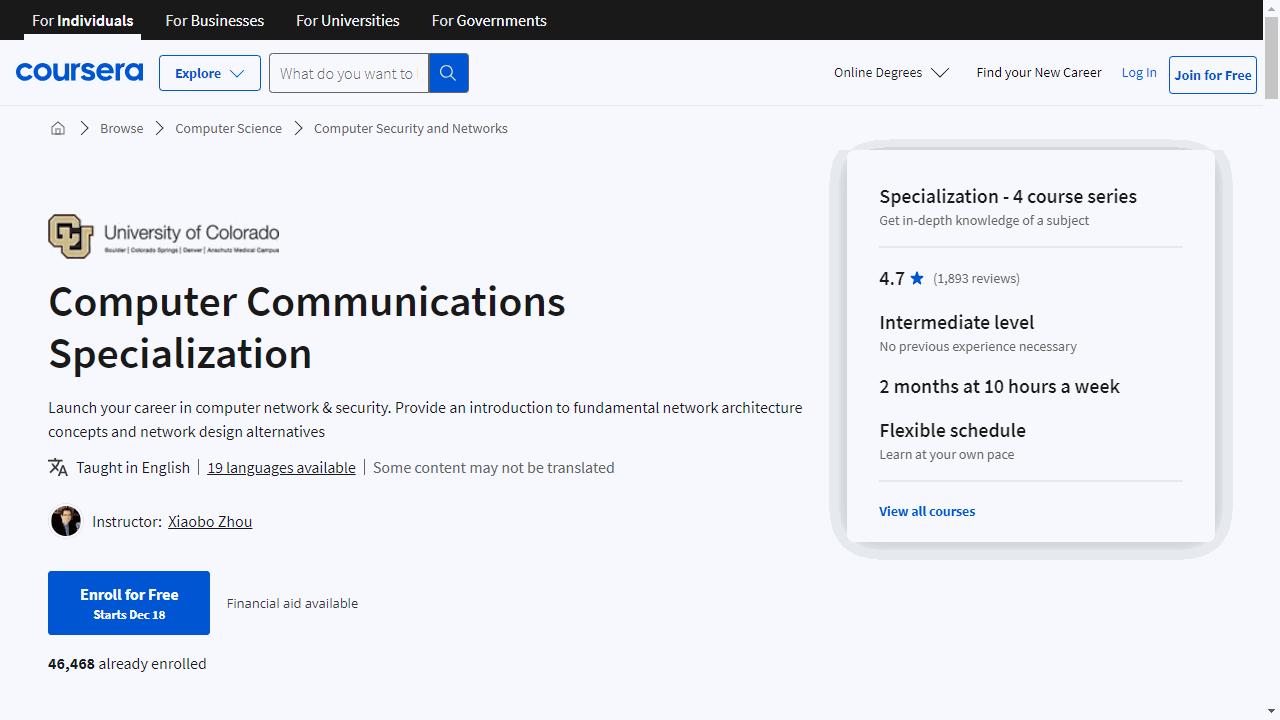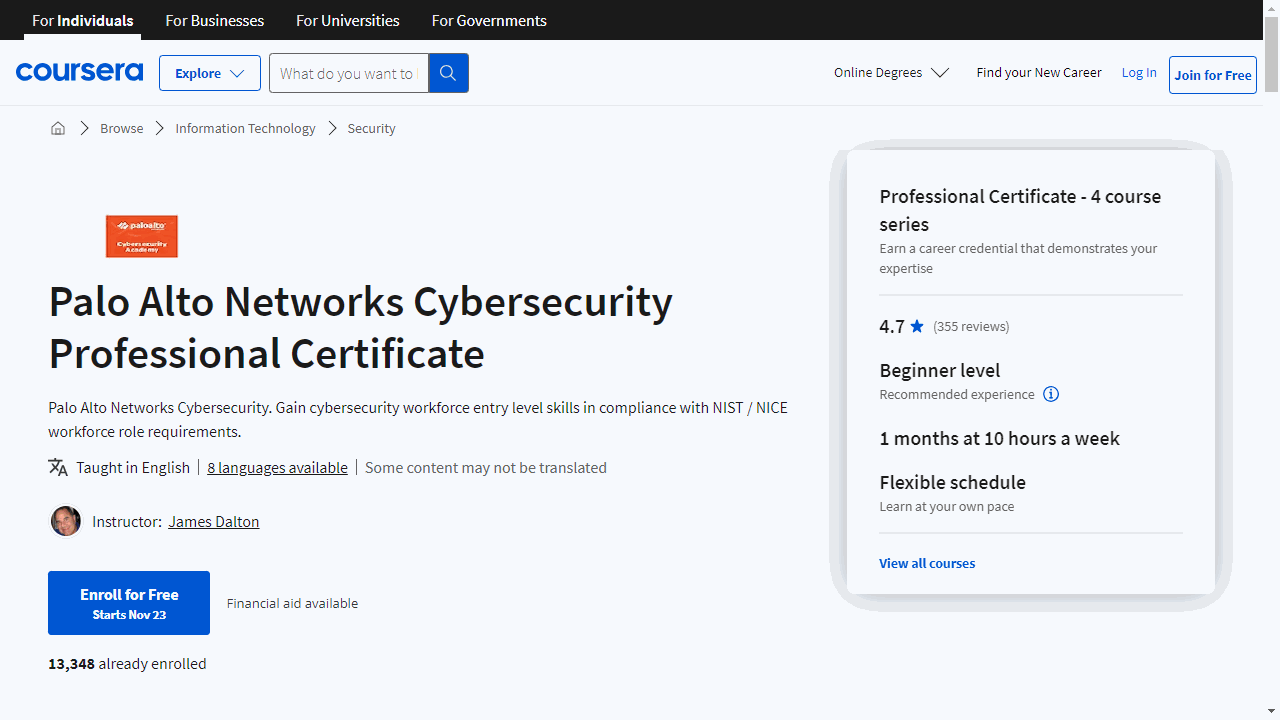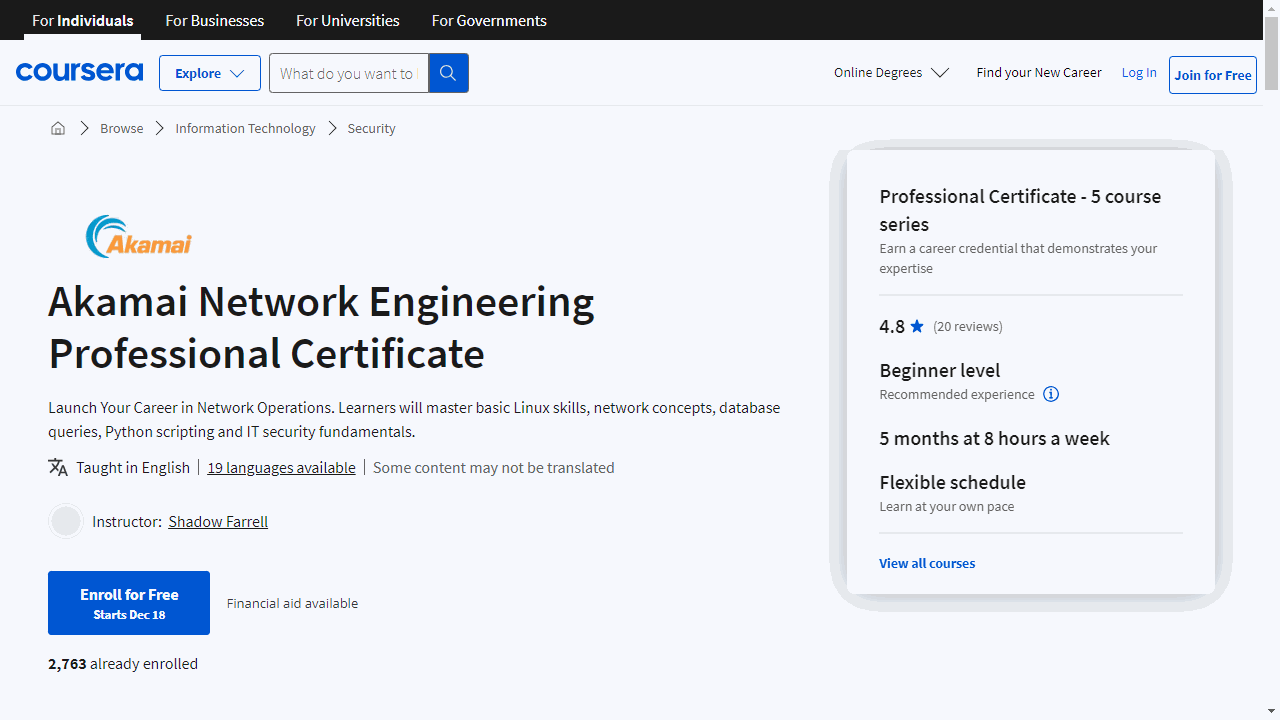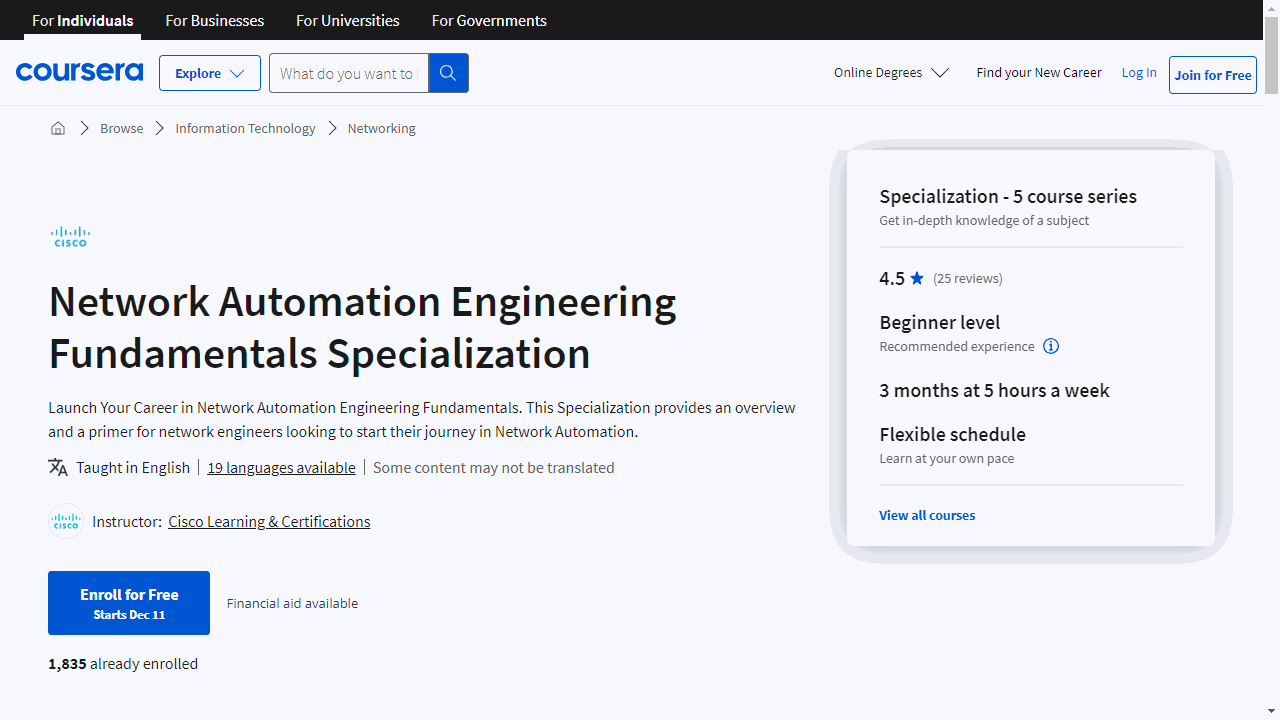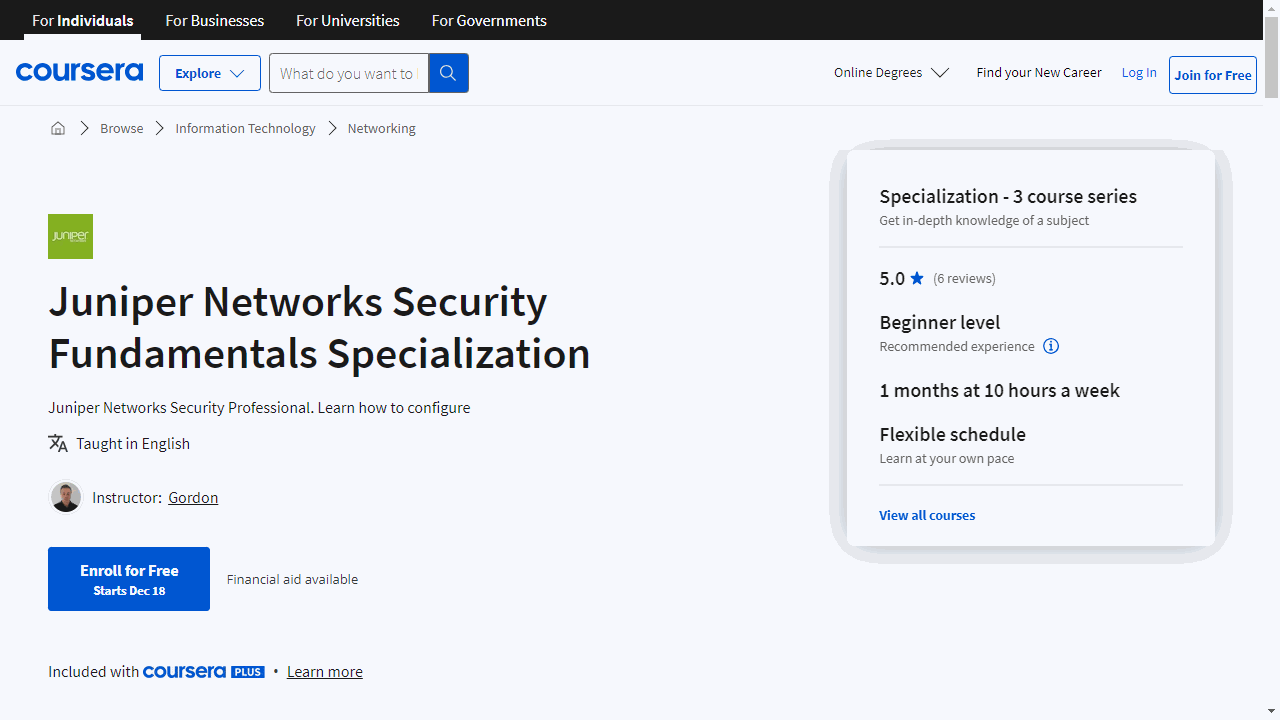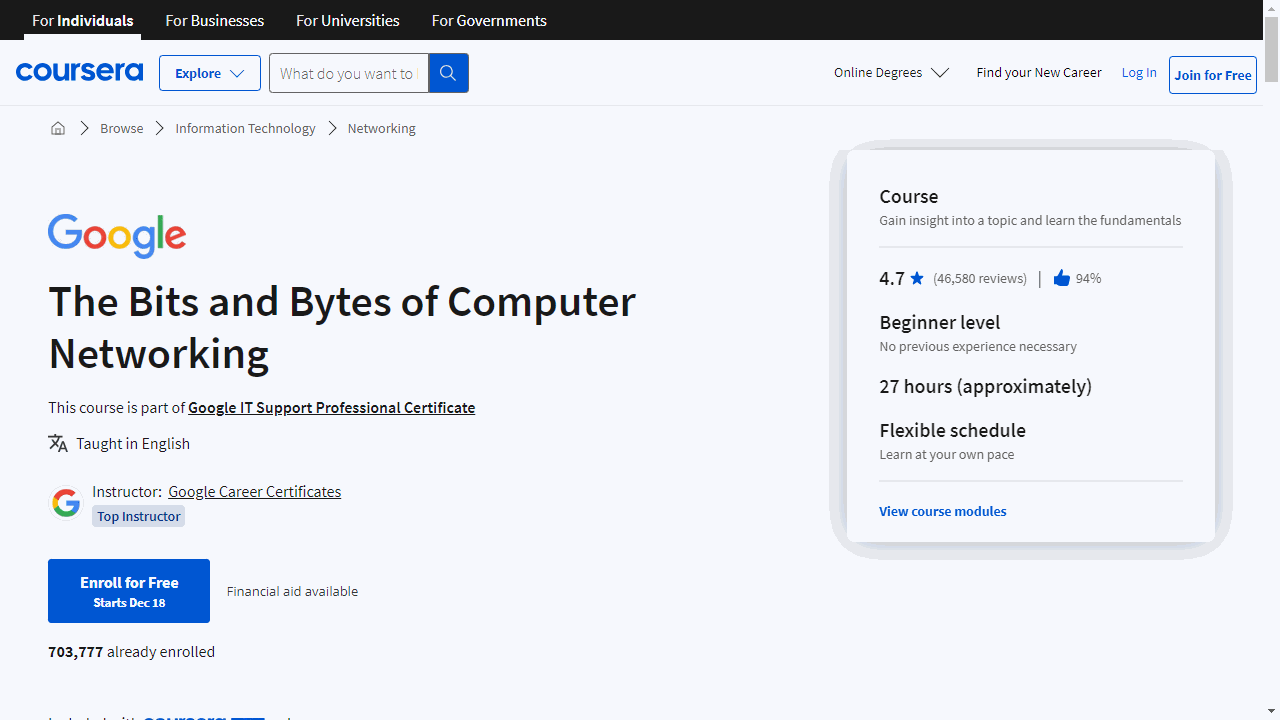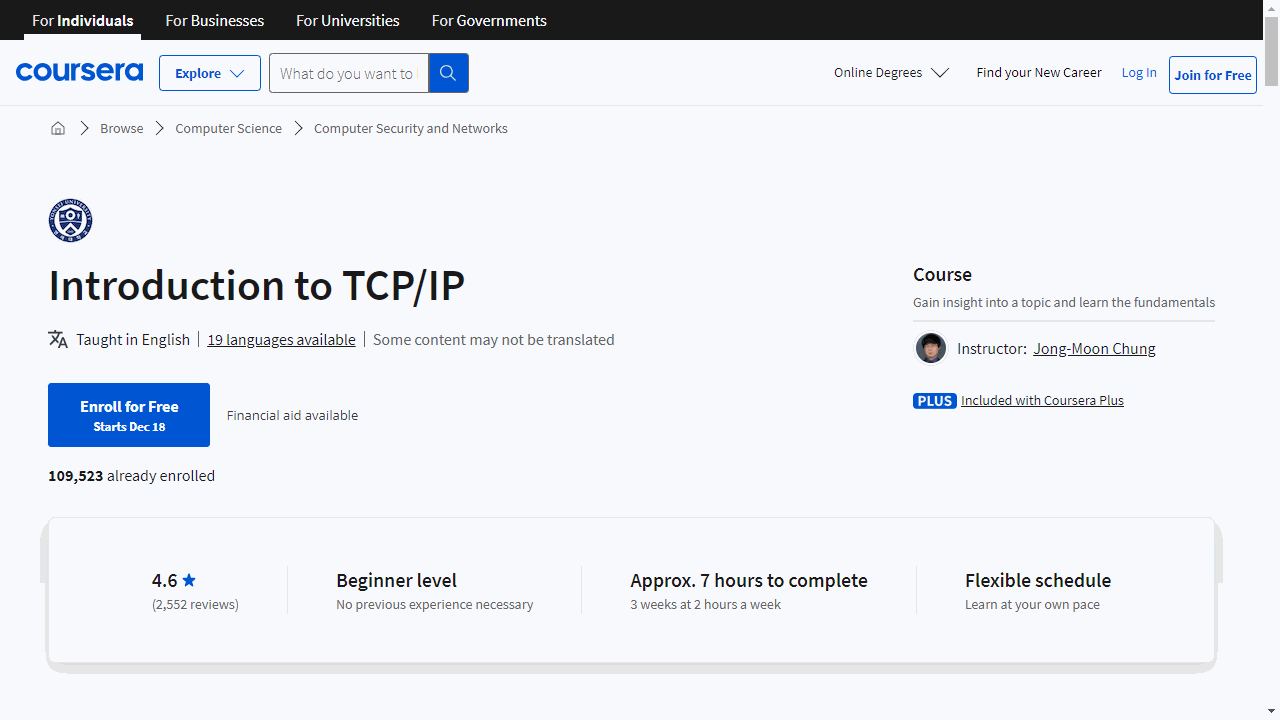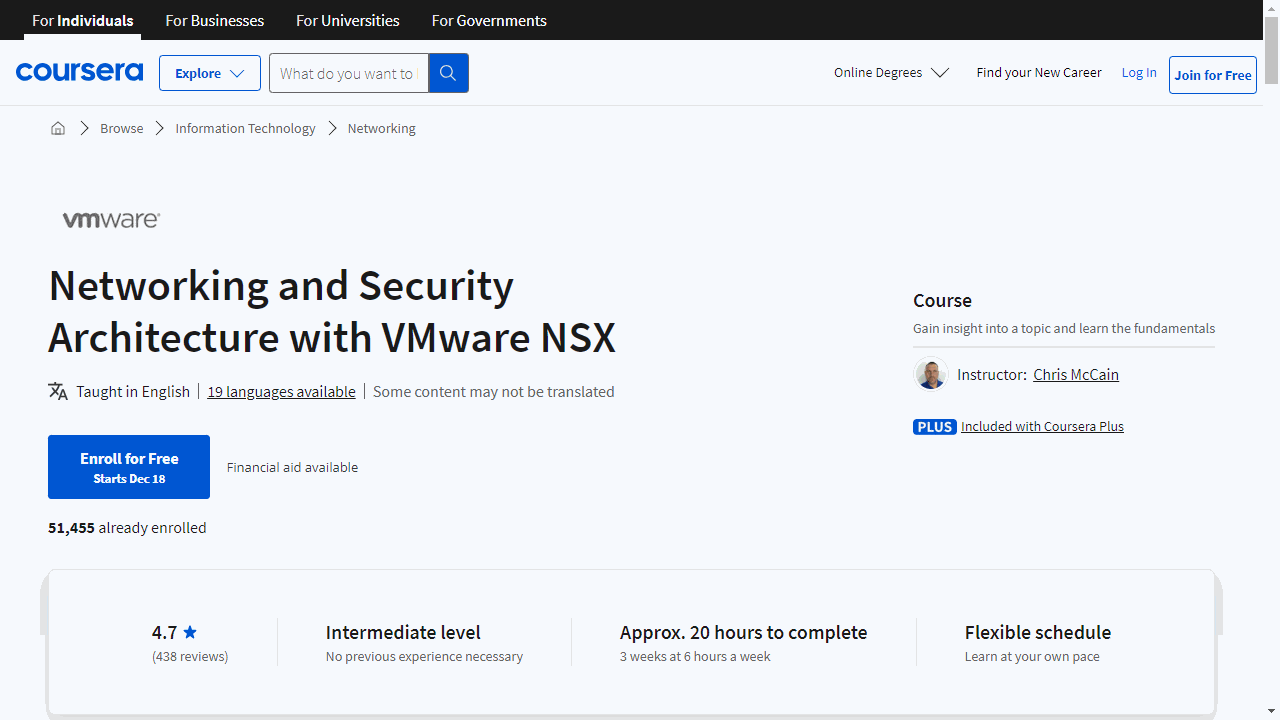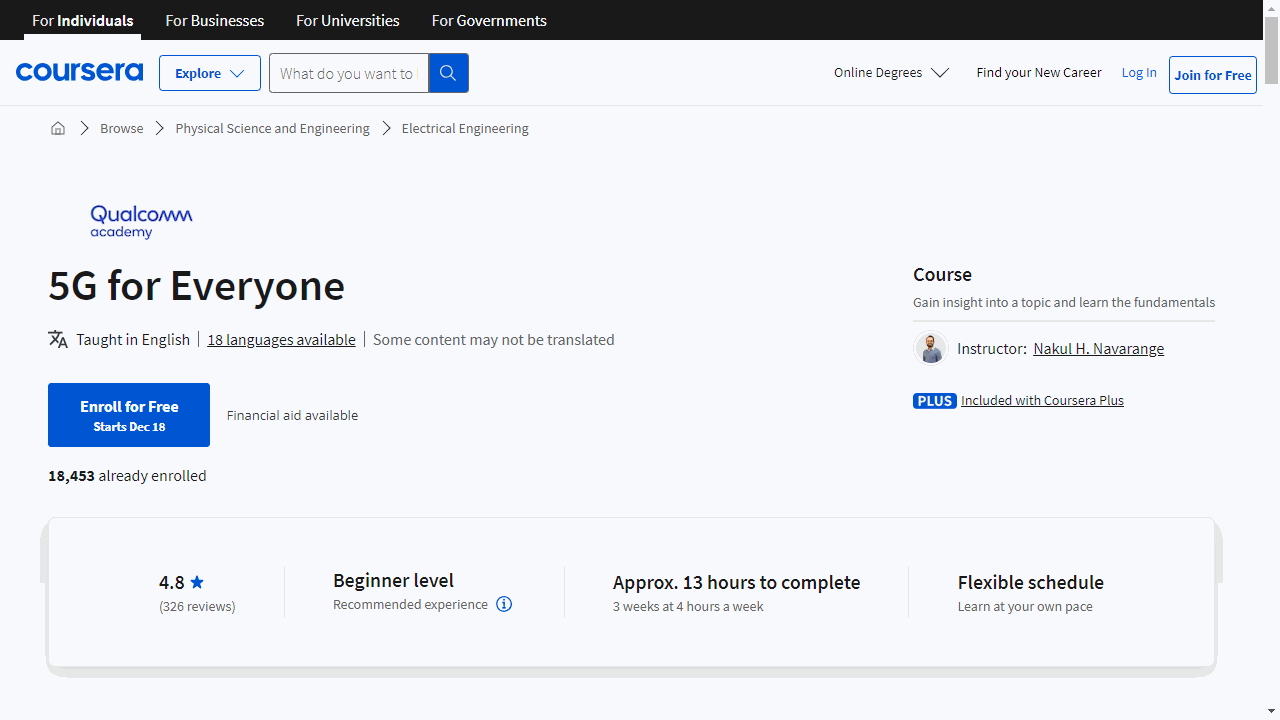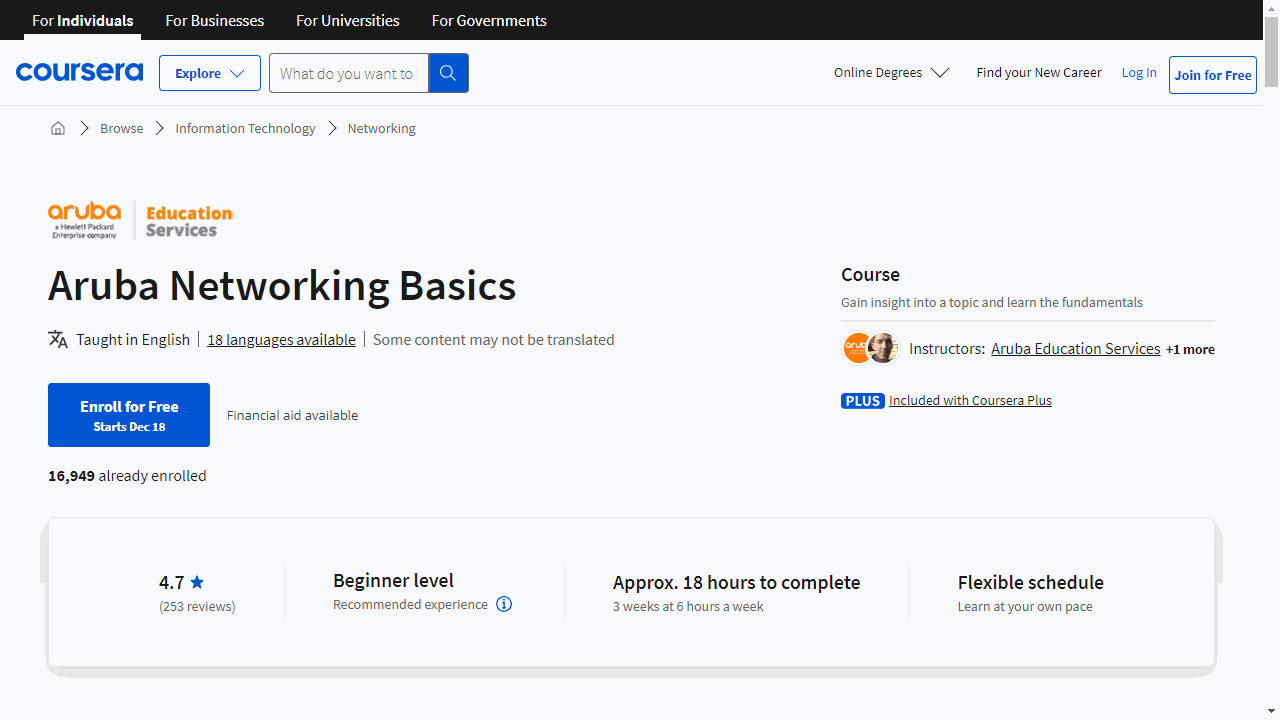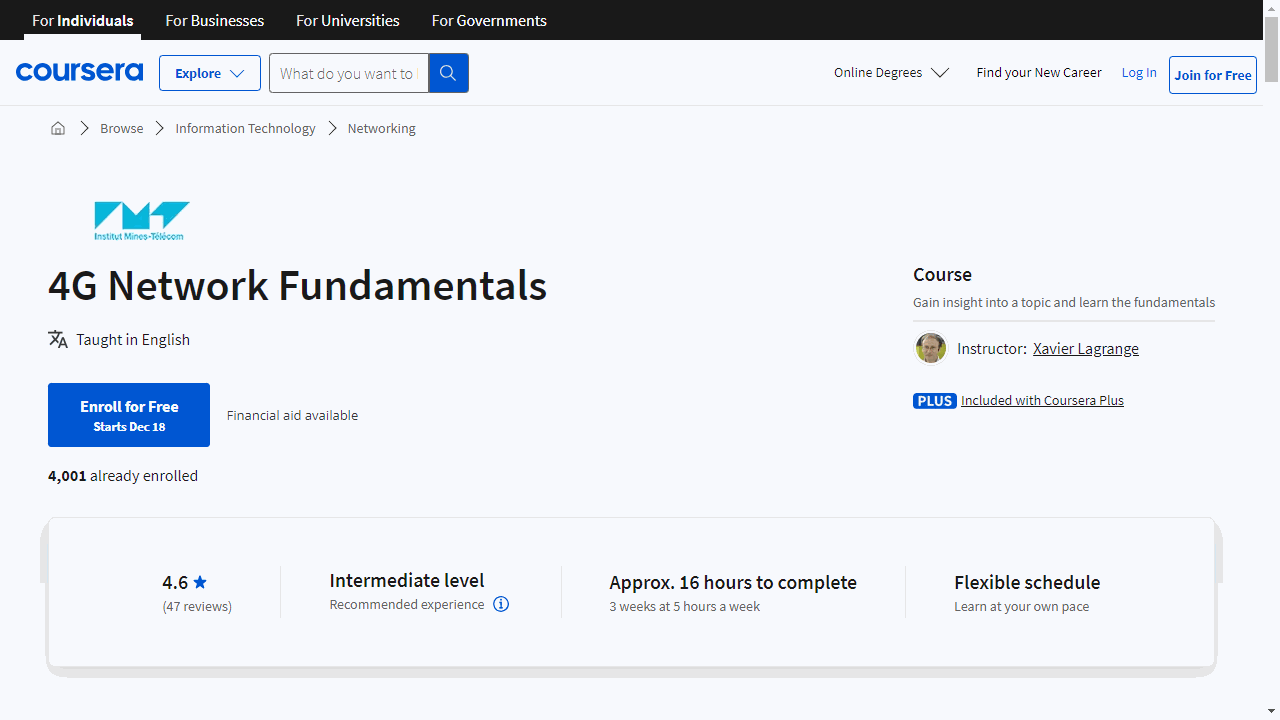Computer networking is the backbone of the modern world, connecting individuals, businesses, and devices across vast distances.
Understanding how networks work is crucial for anyone seeking a career in technology, whether it’s as a network engineer, cybersecurity specialist, or software developer.
Learning about computer networking equips you to design, implement, and troubleshoot complex network systems, ensuring seamless communication and data flow.
Finding a good computer networking course on Coursera can be overwhelming, with numerous options available, each with its own focus and approach.
You’re looking for a program that’s comprehensive, engaging, and taught by experts, one that aligns with your learning style and career goals.
For the best computer networking course overall on Coursera, we recommend the Preparing for Google Cloud Certification: Cloud Network Engineer Professional Certificate.
This program offers a deep dive into Google Cloud networking, equipping you with the skills needed to confidently design, build, and manage cloud networks.
The curriculum covers core Google Cloud services, advanced network concepts, and hands-on lab exercises, preparing you not only for a career in cloud networking but also for the Google Cloud Network Engineer certification.
This is just one excellent option among many great computer networking courses available on Coursera.
Keep reading for more recommendations tailored to different learning levels, specific networking technologies, and career paths.
Preparing for Google Cloud Certification: Cloud Network Engineer Professional Certificate
Provider: Google Cloud
This comprehensive program is your ticket to mastering Google Cloud networking and getting certified.
Kick off with “Google Cloud Fundamentals: Core Infrastructure” to grasp the basics of Google Cloud.
You’ll get to grips with services like Google Compute Engine and Google App Engine, and learn to manage resources effectively.
By the end, you’ll confidently build a basic Google Cloud infrastructure and select the best storage options for your projects.
Move on to “Networking in Google Cloud: Defining and Implementing Networks,” where you’ll deep-dive into Google Cloud VPC networks, subnets, and firewalls.
You’ll learn to set up secure, efficient networks, manage access, and master the art of load balancing to keep your applications running smoothly.
Then, “Networking in Google Cloud: Hybrid Connectivity and Network Management” elevates your skills.
You’ll explore advanced network design, discover how to connect securely to Google Cloud VPC networks, and choose the right Network Service Tier for cost and performance balance.
Plus, you’ll tackle network monitoring and logging to troubleshoot like a pro.
Finally, “Hands-On Labs in Google Cloud for Networking Engineers” offers practical, hands-on experience.
You’ll configure networks, troubleshoot in real-time, and implement load balancers to ensure high availability.
Throughout these courses, key entities like DNS, firewalls, routers, and load balancers are not just terms but tools you’ll become adept at using.
You’ll also become proficient in cloud storage, access control, and network performance optimization.
By completing this professional certificate, you’ll not only gain valuable hands-on experience but also prepare yourself for a career as a Cloud Network Engineer.
Networking in Google Cloud Specialization
Provider: Google Cloud
Starting with “Google Cloud Fundamentals: Core Infrastructure” to grasp the basics.
You’ll learn to navigate Google Cloud’s core services, manage infrastructure, and select the best storage options.
This course is essential for understanding the platform’s computing services, including Google Compute Engine and Google App Engine.
Move on to “Networking in Google Cloud: Defining and Implementing Networks” to deepen your knowledge.
You’ll configure Google Cloud VPC networks, subnets, and firewalls, and learn how to manage network access.
By the end, you’ll be adept at setting up load balancers and steering DNS traffic, ensuring efficient network operations.
The final course, “Networking in Google Cloud: Hybrid Connectivity and Network Management,” builds on your growing expertise.
Here, you’ll tackle advanced networking concepts like design patterns and private connections.
You’ll also discover how to optimize network performance and manage costs effectively.
Plus, you’ll gain skills in monitoring and logging to quickly resolve network issues.
Throughout these courses, key entities such as DNS, load balancing, and routers are not just discussed; they’re part of your hands-on learning experience.
You’ll also become proficient in access control and cloud storage within the Google Cloud Platform.
Computer Communications Specialization
Provider: University of Colorado System
This comprehensive program covers everything from the basics to advanced networking concepts, ensuring you’re well-equipped for the tech-driven world.
Kick off with “Fundamentals of Network Communication,” where you’ll explore the evolution of networks and the principles of layered architecture.
If you have experience in C or Java programming and a grasp of computer science, you’ll find yourself at home learning about error control techniques like parity checks and checksums.
In “Peer-to-Peer Protocols and Local Area Networks,” you’ll tackle the challenge of reliable data transfer over unpredictable networks.
Discover how medium access control protocols ensure smooth communication in local and wireless LANs, a must-know for seamless data exchange.
“Packet Switching Networks and Algorithms” offers a deep dive into the backbone of network communication.
You’ll learn how networks provide services and manage internal data traffic, mastering concepts like routing and congestion control that keep networks efficient.
The final course, “TCP/IP and Advanced Topics,” provides an in-depth look at the protocols that are the lifeblood of the Internet.
Understand the intricacies of IP addresses, the TCP three-way handshake, and flow control.
Plus, you’ll get a primer on cutting-edge topics like Multicast and network security.
By the end of this specialization, you’ll have a robust set of skills in key areas such as TCP/IP, scalability, and error control, all crucial for a career in computer networking.
This program is a direct path to becoming proficient in ensuring reliable communication across complex networks.
Palo Alto Networks Cybersecurity Professional Certificate
Provider: Palo Alto Networks
Begin with the “Palo Alto Networks Cybersecurity Foundation” course, where you’ll grasp the essentials of the cybersecurity field.
You’ll learn to identify and mitigate network threats, configure security zones, and implement policies on next-generation firewalls.
This course equips you with the knowledge to tackle modern computing challenges, understand attacker tactics, and secure enterprise networks.
The “Palo Alto Networks Network Security Fundamentals” course deepens your understanding by focusing on the principles of maintaining a secure network.
You’ll emerge with the ability to describe security concepts and apply basic configuration techniques, ensuring you can both conceptualize and apply network defenses.
In the “Palo Alto Networks Cloud Security Fundamentals” course, you’ll navigate the complexities of cloud security.
You’ll learn to protect cloud and SaaS applications, set up secure containers, and conduct vulnerability scans.
This course is crucial for mastering the protection of data in the cloud, a skill highly sought after in today’s tech-driven market.
Finally, the “Palo Alto Networks Security Operations Fundamentals” course introduces you to SecOps, the proactive arm of cybersecurity.
You’ll explore how to collect intelligence, analyze threats, and leverage automation to respond to incidents efficiently.
This course is about enhancing your ability to protect digital assets in real-time.
Each course is designed to build on the last, culminating in a well-rounded skill set that includes authentication, cryptography, and cloud computing security.
Akamai Network Engineering Professional Certificate
Provider: Akamai Technologies, Inc.
This is a well-rounded program that gives you hands-on skills in network engineering.
In “Operating Systems Fundamentals,” you’ll master Linux, from file management to security settings.
You’ll even build your own Linux machine, getting comfortable with the command line and system management.
“Networking Fundamentals” takes you through network theory and the internet’s backbone.
You’ll learn about the OSI and TCP/IP models, ethernet, and how to manage routers and switches.
Plus, you’ll develop troubleshooting skills and use network simulation software for real-world practice.
With “Managing Relational Databases,” you’ll dive into SQL, designing databases, and extracting data for analysis.
This course is perfect if you’re keen on understanding database structures and crafting complex queries.
“Python Scripting Fundamentals” introduces you to programming with Python.
You’ll start with the basics and quickly move to creating functions and scripts that interact with databases and web content.
By the end, you’ll be adept at connecting websites to databases and managing dynamic content.
Finally, “Introduction to IT Security” is crucial for network protection.
You’ll cover everything from risk management and IAM to cryptography and network defense strategies.
You’ll also learn to respond to security incidents and plan for business continuity.
Each course culminates in a capstone project, allowing you to demonstrate your expertise.
Network Automation Engineering Fundamentals Specialization
Provider: Cisco Learning and Certifications
This set of courses is designed to empower network professionals with the automation skills needed to excel in today’s network industry.
It’s preferrable if you have a CCNA certification or equivalent knowledge.
Kick off with “Introduction to Network Automation,” where you’ll understand the crucial role of automation in network management.
You’ll interpret Python scripts tailored for network tasks, setting the stage for more advanced learning.
Make sure you’re up to speed with network routing, switching, and have some Python and Linux background.
Move on to “Using APIs for Network Automation,” where APIs take center stage.
You’ll decode data formats, craft API calls, and automate network devices using Python.
This course is a fit if you’re already versed in networking basics and Python scripting.
Dive deeper with “Ansible for Network Automation.”
Here, you’ll master Ansible, an essential tool for simplifying network management, and Jinja2 for creating flexible automation tasks.
By the end, you’ll be creating Ansible playbooks and Jinja2 templates to manage networks efficiently.
In “DevOps for Network Automation (NetDevOps),” you’ll explore DevOps tools and methodologies that enhance network operations.
You’ll differentiate between software development methods and apply DevOps principles to network tasks, paving the way for more streamlined operations.
Finally, “Introducing Model-Driven Programmability” will familiarize you with YANG data models and the standardized approach they provide for network device interactions.
You’ll delve into NETCONF, RESTCONF, and Python libraries that interface with these technologies, rounding out your network automation expertise.
Each course builds upon your knowledge of network fundamentals and Python, preparing you to automate network operations effectively.
CompTIA a+_ network Specialization
Provider: CompTIA
This trio of courses equips you with the know-how to navigate and excel in the networking realm.
Start with “Network Installation Fundamentals” to lay your groundwork.
You’ll learn to manage network clients and understand the essentials of network connection media.
Plus, you’ll delve into the significance of virtualization in today’s networks.
This course is ideal if you’re new to the field, aiming to give you practical skills like configuring network clients and grasping the impact of data centers, cloud computing, and IoT on networking.
Move on to “Network Support Fundamentals” to sharpen your ability to maintain and secure networks.
This course introduces you to network security, performance monitoring, and professional support techniques.
It’s a direct path to the CompTIA Network+ certification, a credential that can propel your career forward.
You’ll acquire the know-how to secure enterprise networks, use monitoring tools, and troubleshoot effectively.
Lastly, “Application Security Support Fundamentals” offers a foray into cybersecurity.
You’ll cover Linux server operations, script development, and data management basics.
This course is a part of two specializations, allowing you to choose between focusing on network or cybersecurity.
It sets the stage for pursuing CompTIA Network+ or Security+ certifications, depending on your interest.
These courses stand out for their flexibility, allowing you to learn at your own pace.
With the IT job market flourishing and over 135,900 networking and 663,434 cybersecurity positions available in 2023, the skills you gain are in high demand.
Networking professionals can earn a median salary of $90,520, while cybersecurity experts can earn $112,000 annually.
By choosing the CompTIA a+_ network Specialization, you’re not just learning; you’re building a foundation for a lucrative career.
The practical, hands-on approach ensures you’re job-ready, with certifications that employers value.
Juniper Networks Security Fundamentals Specialization
Provider: Juniper Networks
This specialization equips you with a robust understanding of network security, focusing on Juniper Networks’ cutting-edge technology.
Kick off your learning journey with “Juniper Networks Security Concepts and Initial Configuration.”
Here, you’ll grasp the essentials of network security design and become proficient with the Junos operating system, crucial for managing Juniper’s SRX Series devices.
You’ll gain practical experience with the Junos CLI and J-Web interfaces, setting the stage for successful initial configurations.
The course also covers the configuration of security zones, screen objects, and security policies, ensuring you know how to fortify a network’s defenses.
Progress to “Security Features and Advanced Threat Prevention,” where you’ll delve into advanced security services like Intrusion Prevention Systems (IPS) and user-based firewalls.
You’ll understand how to deploy antivirus, antispam, and content filtering to shield networks from various online threats.
The course introduces you to Juniper ATP Cloud, Juniper’s solution for combating sophisticated cyber threats, and demystifies the critical role of Network Address Translation (NAT) in network security.
Conclude with “Security Platforms, IPsec, and Troubleshooting,” where you’ll explore the configuration and monitoring of IPsec VPNs, essential for secure internet data transmission.
Discover Juniper Secure Connect for flexible VPN deployment and acquire the troubleshooting skills necessary to maintain SRX Series devices’ peak performance.
Throughout these courses, you’ll build competencies in key areas such as NAT, IPsec, VPNs, and troubleshooting.
You’ll become conversant with terms like firewall, Unified Threat Management, and the Junos operating system, all while learning from a leader in the networking industry.
The Bits and Bytes of Computer Networking
Provider: Google
Starting with the TCP/IP Five-Layer Network Model, you’ll understand the structure that keeps the internet running.
You’ll learn about the roles of cables, hubs, switches, and routers directly from professionals like Alex and Sergio, who share their insights on the importance of networking and the life of a network engineer.
You’ll delve into the technicalities of data transmission, including twisted pair cabling, network ports, and Ethernet.
You’ll also discover how MAC addresses work and the differences between unicast, multicast, and broadcast signals.
Real-world applications are highlighted by IT experts like Victor, who brings practical experience to the table.
The course guides you through setting up a network, with interactive elements like discussion forums and opportunities to connect with peers.
Plus, completing the course could earn you a dual credential from Google and CompTIA A+.
As you progress, you’ll tackle IPv4 addressing, subnetting, and routing.
The transport and application layers are demystified, explaining protocols and services like DNS and DHCP that keep networks functioning smoothly.
Connecting to the internet is more than just plugging in a cable; you’ll explore various technologies from dial-up to fiber optics, and dive into wireless networking, including security protocols and the emerging Wi-Fi 6 standard.
Troubleshooting is a critical skill, and this course equips you with tools like ping and traceroute to diagnose and resolve network issues.
You’ll also get a glimpse into the future with cloud storage and IPv6.
With supplemental readings and glossaries, you’ll have all the resources you need to understand complex terms and concepts.
This course is designed to be practical, informative, and directly applicable to a career in IT.
Introduction to TCP/IP
Provider: Yonsei University
Starting with the basics, you’ll learn how to set up your PC’s internet connection using DHCP, which automatically gets you online without a fuss.
You’ll also delve into IP gateway and router configurations, and decode the IP routing table to see the pathways data takes across networks.
The course then demystifies the layers and functions of TCP/IP, comparing it to the OSI model to give you a comprehensive view of network architecture.
You’ll get to know IPv4 and IPv6 – the protocols that assign addresses to devices on the internet – and understand how TCP and UDP are used for sending data.
Routing and functions of the internet come next, where you’ll explore how data packets navigate through the web.
This knowledge is crucial for grasping the big picture of internet connectivity.
On the security front, the course tackles the most common internet attacks and emerging security threats.
You’ll learn about cyber attacks and how to protect networks, an increasingly vital skill in today’s digital world.
Hands-on experience comes in the form of using Wireshark, a powerful tool for analyzing network traffic.
You’ll install it, check your IP configuration, and learn to dissect internet packets, giving you practical skills alongside theoretical knowledge.
Key terms like DHCP, TCP/IP, Internet Security, TCP, UDP, IPv4, IPv6, and more are woven throughout the course, ensuring you become fluent in the language of networking.
Networking and Security Architecture with VMware NSX
Provider: VMware
This course is a comprehensive dive into the world of network virtualization and security, giving you hands-on experience with VMware’s NSX platform.
Starting with the basics, you’ll trace the evolution of VMware from simple hypervisor solutions to the sophisticated Virtual Cloud Network of today.
This foundational knowledge is crucial for grasping the complexities of modern networking.
As you progress, the course breaks down the NSX architecture, guiding you through components like the Edge Services Gateway with interactive labs.
This practical approach ensures you not only learn but also apply your knowledge in real-world scenarios.
Security is a core focus of the course.
You’ll explore how NSX serves as a robust security solution, delve into micro-segmentation for network protection, and discover how to secure end-user computing.
The course also tackles DMZs, allowing you to safeguard various network segments regardless of their location.
You’ll gain insights into the NSX security ecosystem, including network and guest introspection, and delve into VMware AppDefense to ensure your applications remain secure.
The course also addresses application continuity, teaching you about multi-site networking and security—a must-have skill for managing expansive networks.
You’ll witness these concepts in action through a hands-on demo.
Disaster recovery is another critical area covered.
Learn to pair NSX with Site Recovery Manager (SRM) for seamless operations during disruptions.
Plus, the course introduces VMware Cloud on AWS, expanding your expertise into cloud networking.
Beyond technology, the course emphasizes operational transformation, ensuring you understand how to integrate tools like vRealize Automation and Network Insight with NSX for improved network automation and visibility.
Lastly, the course touches on the integration of NSX SD-WAN by VeloCloud and its compatibility with Cisco underlays, showcasing NSX’s versatility in diverse networking environments.
5G for Everyone
Provider: Qualcomm Academy
This course is designed to give you a comprehensive understanding of 5G technology, starting with the basics and progressing to advanced concepts.
You’ll begin with an introduction to wireless communication, learning about radio signals, carrier waves, and modulation.
You’ll understand the intricacies of a phone conversation, including transmission, reception, and the challenges of noise and interference.
The course demystifies the radio spectrum, explaining bandwidth and how channels are shared using FDD and TDD.
You’ll grasp factors that influence data rates and get a clear picture of what a cellular network is.
As you delve into the evolution from 4G to 5G, you’ll discover the capabilities of 5G NR and its service classes: eMBB, m-MTC, and URLLC.
These classes cater to different needs, from high-speed internet to connecting a multitude of devices.
You’ll get familiar with 5G network terminology and concepts, including network architecture and the principles behind technologies like scalable OFDM, advanced channel coding, and massive MIMO.
The course also covers mobile mmWave technology, explaining its advantages and deployment strategies for various environments.
Beamforming, a technique that enhances signal direction and strength, is another key topic.
You’ll learn how it works with massive MIMO to improve network coverage and efficiency.
The course takes you through the transformation of RAN, highlighting the benefits of virtualization.
You’ll compare traditional RAN with virtualized RAN (vRAN) and understand the motivations behind this shift.
For those interested in the industrial applications of 5G, the course explores private networks, detailing their advantages for Industrial IoT (I-IoT).
You’ll examine deployment considerations and spectrum options for these specialized networks.
Security is a critical component of 5G, and you’ll gain insights into the enhanced system-level design and measures to protect user privacy.
Throughout the course, interactive Q&A sessions and supplemental readings will reinforce your learning.
And if you’re eager to expand your 5G knowledge further, Qualcomm Technologies offers additional training opportunities.
Software Defined Networking
Provider: The University of Chicago
You’ll jump right in and start by creating your own virtual network, learning to navigate Mininet and its Python API.
As you progress, you’ll delve into the core of SDN—the separation of control and data planes.
You’ll understand why this matters and how it revolutionizes network management.
By week two, you’re deep into SDN controllers, customizing them for specific tasks and exploring industry-standard controllers like ODL and Ryu.
Virtualization is your focus in week three.
Here, you’ll apply your knowledge to scenarios like datacenters and learn about network functions virtualization.
Plus, you’ll see how Docker fits into the networking puzzle.
Week four is all about speed and efficiency with programmable data planes.
You’ll get to grips with P4, a high-level language that’s changing the way networks are programmed.
The fifth week introduces you to Northbound APIs and languages designed for SDN, such as Frenetic and Pyretic.
You’ll learn how to compose SDN policies effectively, a skill that’s in high demand.
In week six, you’ll see SDN in action across various domains, from data centers to internet exchange points, giving you a broad view of its applications.
Week seven is about ensuring everything works as it should.
You’ll cover verification techniques for configurations and planes, a critical step for network reliability and security.
Throughout the course, interviews with SDN pioneers like Nick McKeown and Martin Casado offer you rare insights into the industry.
By the end of this course, you’ll not only understand SDN but also be able to apply it practically.
Aruba Networking Basics
Provider: HPE Aruba Networking
You’ll begin with the essentials, understanding how home networks function and getting familiar with the inner workings of an Aruba Switch.
The course is practical, with labs that let you experiment with Layer Two and Three networking.
You’ll learn by doing, which is the best way to grasp complex concepts like encapsulation and protocols.
Regular pop quizzes will help reinforce your learning and ensure you’re absorbing the material.
Key skills you’ll acquire include backing up and erasing configurations on an Aruba CX Switch.
This knowledge is crucial for maintaining network integrity and recovering from mishaps.
You’ll also become adept at troubleshooting, a skill that can set you apart in the networking field.
VLANs won’t be a mystery anymore, as you’ll learn both the theory behind them and the practical steps to set them up.
The course covers VLAN trunking and managing redundant links, teaching you how to create robust and efficient networks.
Hands-on labs are a core feature of this course.
You’ll reset switches, configure IP addresses, and design networks.
Understanding routing and gateways will become second nature, allowing you to direct network traffic effectively.
Dynamic routing with OSPF is also on the agenda, giving you a taste of more advanced networking techniques.
By the end of the course, you’ll have a solid foundation in Aruba networking, positioning you well for a career in this field or to take on more complex networking challenges.
4G Network Fundamentals
Provider: Institut Mines-Télécom
This course is a comprehensive guide to understanding mobile networks, focusing on the widely-used 4G technology.
You’ll start with the essentials, learning about the visible elements of mobile networks and how they enable seamless communication.
The course breaks down the complex architecture of 4G networks, making it easy for you to grasp how your device stays connected on the move.
Security is a big part of the curriculum.
You’ll explore how networks verify device identities, protect your communications, and prevent eavesdropping and tracking.
The course also demystifies the distribution of encryption keys and the execution of security procedures during device attachment.
When it comes to the technical side, you’ll delve into OFDM (Orthogonal Frequency-Division Multiplexing), a method crucial for efficient data transmission.
You’ll understand how spectrum resources are allocated and how your device is informed about its usable resources.
The course also covers the quality of service levels provided by the radio interface, ensuring you know how your network maintains a reliable connection.
You’ll learn about the protocols for data exchange, how to rapidly transmit packets, and the intricacies of establishing secure tunnels for communication.
Mobility management is another highlight.
You’ll discover how your device registers with new cells, how handovers keep your service uninterrupted, and what happens during periods of inactivity.
The course explains how servers can reach your device after it’s been idle and how quality of service (QoS) is maintained in a 4G network.
By the end of this course, you’ll have a clear understanding of how data packets travel to and from your device, how the LTE core network interfaces with your device, and the role of entities like MME, RLC, and AP in the networking process.
Also check our posts on:
